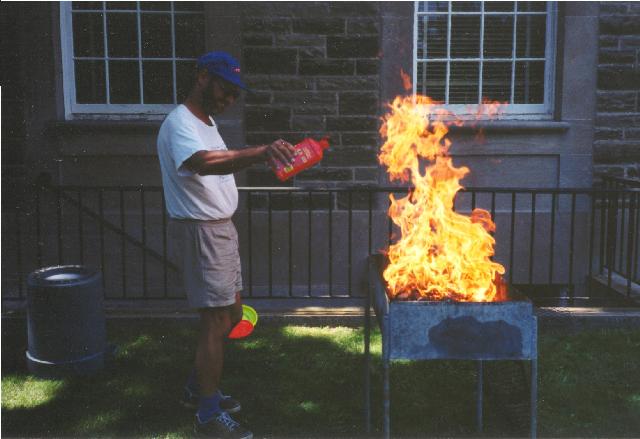
Stefan demonstrating how mass transfer can lead to flaring
in some peculiar binary systems
Volume 31, Number 2
November 2000



There have been some changes in the editorial staff of the DOINGS. Brian Beattie left DDO for New York and the allure of the dot-coms this past April, but his influence on the DOINGS is still apparent in the layout and design. Thanks to Brian for all the work he put into the DOINGS over the years! He has been replaced as Co-editor by Mike Allen, who has added some nice touches of his own. Tracy Clarke, who did a great job of galvanizing the students to contribute, has completed her Ph.D. degree and has moved on to bigger and better things at the VLA. Chris Tycner is the new Associate Editor for the students and brings to the position some very impressive persuasive powers. He is responsible for getting all the new students to pose for pictures and to write about themselves - a daunting task. And as for me, I'm still around, providing some continuity and perspective.
All the gains and losses have cost us time, so we've missed a few
deadlines, but we're learning as we go. We hope that you enjoy reading
this and future issues. so much that you will want to be a
participant. Send us news and views; we welcome all contributions:
large or small, formal or informal, funny or sad, scientific or
personal.
This gift was special because it was outside the regular awards programme- a 'custom award', so to speak. (Marlene was awarded the first PAM Division Achievement Award in 1997.)
For details of what she did to earn the award and a photo, see the
PAM Division Newletter
article at
www.sla.org/division/dpam/pam-bulletin/vol28/no1/marlene.html
NEW MSc STUDENTS
|
Paula Ehlers Hi! my name is Paula Ehlers and I'm working with Prof. Barth Netterfield. I'm from U. of T. and took mainly astronomy, physics and math courses in my undergrad program. My research interests include the Cosmic Microwave Background, General Relativity, Cosmology and Star Formation. |
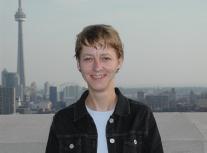 |
|
Megan McClure I completed my B.Sc. in Astrophysics at the University of Calgary. My research experience at Calgary involved modeling light curves for extra-solar planet transits in the globular cluster 47 Tuc. My research interests are actually in the field of cosmology. I am interested in inhomogeneous models of the universe and the evolution of the universe's structure. In my spare time, I listen to Nirvana (or similar alternative music), write dark and disturbing poetry, study Buddhist philosophy, and play ice hockey (goal). |
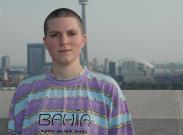 |
|
Vjera Miovic My name is Vjera, but it might be easier to figure out how to pronounce it if you imagine it is written as 'Viera'. I was born in Belgrade, Yugoslavia and lived there for the first 17 and 2/3 years of my life. I finished my undergraduate studies in astrophysics at the University of Belgrade. Currently I'm enrolled in Collaborative M.Sc. programme in astrophysics. My scientific interests are mainly in cosmology and gravitation. I'm still in search of a supervisor for my Master's project, so I can't be more specific at this point. My highest achievement was climbing to the top of Triglav, a 2864m peak in Slovenian Alps in the summer of 1997, which I did with Sasa who is also in the M.Sc. Astrophysics programme at U of T, but through the Physics Dept. I like to walk through the leaves of all colours fallen from the trees in the fall. I like to eat - I'm not picky. I like to be awakened by the sun. I usually say that my favourite colour is orange when I'm asked. I like many more things, but there's not enough room here for describing them all... |
|
|
Lawrence Mudryk I was born in Edmonton, Alberta and spent the first 18 years of my life on a farm near a town called Thorhild. I received my undergraduate degree in Physics from the University of Alberta over the course of five years. The extra year was spent in an internship program discovering the 'If it works, who cares why?' slant to industrial research. Here at Toronto, I am in the collaborative program working with Doug Johnstone on the ISM. My background in astronomy is comparable to that of the average housefly - truly exceptional houseflies may have more knowledge in certain areas. I am an avid swimmer, having worked as a lifeguard for a number of summers. I also enjoy reading and have the tendency to be in the middle of several books at once. Finally, I like to think that in a good percentage of alternate universes I've dedicated my life to becoming a concert pianist rather than a physicist. I can't seem to squeeze the required practice into this one. |
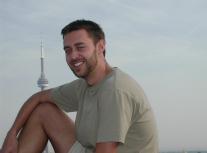 |
|
Jenna (Jennifer) O'Neill's Finally in May of this year, Jenna's misguided attempts to get to space through engineering (Mechanical BASc, UWaterloo, Aerospace MASc, UofT) were overturned for the much more interesting pursuit of understanding its geometry, geography, and the inner workings of its component parts! (Astronomy MSc, started Sept. '00) Along with her avid and varied space interests (Canadian Space Society, Mars Society, hard sf & internet news junkie), she balances everything with a passion for gymnastics, which, unfortunately, has not been remotely reached by her skill... but she keeps trying! And just to prove that she's not as grounded in reality as all that - her main goal in life is to get off this rock!!! |
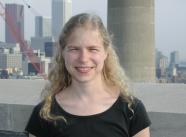 |
|
Tim Rothwell Hi, my name is Tim Rothwell. I'm originally from Prince George B.C. and I've returned there to complete my B.Sc. in Chemistry at the University of Northern British Columbia. I've also spent the past 16 months as a full time research assistant at UNBC in the Chemistry and Physics departments. My main research interests include quasi-classical trajectory studies of H_2 + H_2 in restricted geometries and theoretical low energy electron point-source (LEEPS) microscopy. I'm planning on continuing my work in molecular hydrogen here and I'm also interested in N-body simulations of galactic encounters and mergers. My interests outside of Astro/Chem/Physics include beadwork, celtic knotwork, and basic origami. When my eyes aren't glued to a computer screen, beadloom, or mangled sheet of paper, I curl up with a book by Tom Clancy, James Alan Gardener, or Robert Heinlein. |
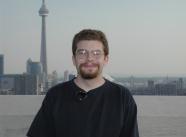 |
|
David Whipps Originally from Pointe-Claire Quebec (a suburb of Montreal), I did
my undergraduate degree in Physics/Astrophysics at Queen's University
in Kingston. I enjoy playing hockey and soccer on a competitive level
as well freeweight training and volleyball on a somewhat less than
competitive level. I'm a big music lover and my CD collection grows on
a weekly basis. My scientific interests are diverse and as of yet I
have not chosen a specific research topic for my M.Sc.
|
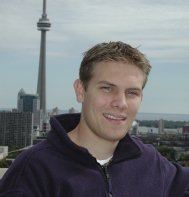 |
NEW PhD STUDENTS
|
Lihong Yao
Here is a brief intro about me:
M.Eng., Electrical & Computer Engineering, McMaster U., Canada M.Sc., Physics & Astronomy, McMaster U., Canada B.Sc.(Honours), Electronics & Applied Physics, Fuzhou U., P.R. China
Software Engineer, Nortel Networks, Canada
|
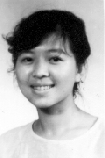 |
NEW MSc STUDENTS, PHYSICS-ASTRONOMY COLLABORATIVE PROGRAM
|
Conrad Rogers My name is Conrad Rogers (nickname *cosmo*, and it has nothing to do with my field...). I'm coming from a four year B.Sc. program at MCMaster in Physics, though I took as much Astronomy and Philosophy as I could get away with. You'll catch me skulking around the Dept., as Physics has put the collaborative astrophysics M.Sc. type people on the 11th floor. I hope to be working with Norm Murray downstairs, dropping rocks on stars. |
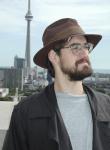 |
NEW POST-DOCTORAL FELLOWS
|
Phil Fischer I completed my PhD at McMaster University in 1993 on "Dynamics of LMC Clusters". I started a postdoc at what was then AT&T Bell Laboratories in New Jersey in January 1993. Since then I have been spending most of my research time using gravitational lensing to measure the distribution of mass in the universe on scales ranging from galaxies to large scale structure. In 1995 I started a Hubble Fellowship at the University of Michigan and in January of 1999 I became a collaborator on the Sloan Digital Sky Survey. I have access to SDSS data for gravitational lensing based studies. In July 2000 I moved to Toronto and started a postdoctoral fellowship with Ray Carlberg. We are collaborating on several lensing based projects to study CNOC1 and CNOC2 fields. On a more personal note I am married to Angela Punnett who is a pediatric haemotologist/oncologist at the Hospital for Sick Children. As a result I have a lot of time on my own which I fill with reading, working around the house, and researching investment ideas. I also go to a lot of movies as I do not own a television. |
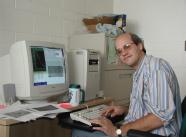 |
|
Siow-Wang Lee I was originally from Singapore and that's where I completed my BSc in Mathematics. I received my MSc in Astronomy from St. Mary's University, working with Prof. George Mitchell, then went to the limestone city (Kingston) to do my PhD with Dr. Judith Irwin. Following my graduation, I spent two years as a postdoctoral fellow at the Institute of Astronomy and Astrophysics in Taipei, Taiwan. Since January 2000, I have been working with Prof. Ernie Seaquist as his postdoctoral fellow. My interest in Astronomy is in the interstellar medium of spiral galaxies, including normal galaxies, starburst galaxies, Seyfert galaxies and ultraluminous infrared galaxies. In the past, I have also worked on problems related to young stellar objects in the Milky Way Galaxy. I work mainly in the centimeter, millimetre and submillimetre wavelengths. Besides astronomy, my other interests include music (mainly Classical and Jazz), travelling (very convenient being an astronomer!), reading (science fictions, fantasies, etc.), fencing, stained glass making (I'm starting to take lessons soon). |
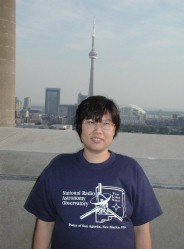 |
Dr. Wendy Freedman is the second Helen Sawyer Hogg Distinguished Visitor. Dr. Freedman will visit the department from Monday, February 26 to Thursday, March 1, 2001.
A public lecture will take place on Tuesday, February 27, 2001 at 7:00 p.m. in the auditorium, Medical Sciences Building.
The organizing committee will meet on a continuous basis to develop the schedule of events. The committee members are:
Please let me take this opportunity to introduce my daughter (the two of us are sharing a "quiet" moment right now while mom sleeps).
Morgaine Saskia van Beers - "Saskia" was born on September 26th at 10:53pm in St. Michael's hospital (but almost in the mid-wife's mini-van!). Mother and father collectively lifted her into this world.
She weighed in at 3005 gms (6 lbs 10 ounces) and 41 cm in length and is in fine health (including a good set of lungs).
Mother and daughter were discharged from the hospital on the 27th of September at noon and after a brief taxi ride, the family has been "relaxing" and getting to know one another at home
Mom and daughter are both doing well and father is "coping" with all the changes.
Thanks to everyone for their support and understanding through this initial transition time.
In May the students reluctantly permitted Wayne Barkhouse not to run again for president of GASA. The new executive is now Tracy Webb as Treasurer, Allen Attard as Secretary and myself as President. Our election season switches to November this year, so look for a shuffle of GASA positions then. The summer has been busy for us with the renovations of the offices and our preparations to make room for all eight new students! We did take time out for the annual DDO Picnic on July 26th, which was well attended and featured great weather, lots of food and drink, softball, frisbee, and leaping flames provided by Stefan.
-Rosemary McNaughton
for the Graduate Astronomy Students' Association
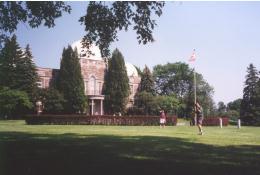 |
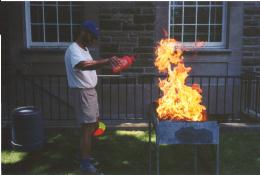 |
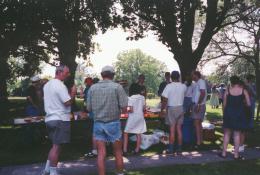 |
OISE is the Ontario Institute for Studies in Education, formerly an
independent provincial education research institute, and now a part of
the University of Toronto. It provides professional education for
pre-service teachers, and also has masters and doctoral programs for
both teachers and education researchers. A few years ago, graduate
student Mindy Kalchman of OISE/UT catalyzed the formation of a research
group in astronomy education, headed by OISE Professor Earl Woodruff,
and John Percy. It now includes three other OISE graduate students -
Nalini Chandra, Habib Mutlak, and Susan Yoon (Mindy Kalchman having
moved on to other things - a PhD in math education, and about to take
up a PDF at Northwestern University). The group's first project was to
investigate astronomy misconceptions among pre-service elementary
school teachers, who now have to teach astronomy as part of Ontario's
new school science curriculum. Misconceptions were widespread, and the
eventual goal is to produce a web-based system for "just in time"
professional development, which teachers can use immediately before
they have to teach the subject. The hope is that, having identified
their own misconceptions, they can use the remediation of these to
strengthen their own teaching. The group is now turning its attention
to the problem of "frames of reference". It turns out that one of the
most difficult problems in learning basic astronomy is being able to
switch from one frame of reference (the observer's) to another (the
external frame of reference pictured in most books). Of course, every
astronomy instructor knows that, but it appears that we are not very
successful in helping our students to deal with the problem! Nalini
Chandra has also been developing some resources related to
Multicultural Astronomy. For more information, see our web site:
www.oise.utoronto.ca/~ewoodruff
ASTRONOMY IN ONTARIO'S SCHOOL SCIENCE CURRICULUM - AN UPDATE
There is now an Earth and Planetary Science course at the Grade 12
level in the new school science curriculum in Ontario. It's not clear
how many schools will offer it, and who will teach it; the Earth
Science portion (not written by John Percy) is at a rather high level;
the Planetary Science portion (written by John Percy) is sufficiently
general for teachers to be able to pitch it to the grade 12 level. For
a look at the course, see the Ministry of Education web site:
www.edu.gov.on/eng/document/curricul/secondary/grade1112/science/science.html
and go to the Earth Science course.
A BRIEF ENCOUNTER WITH GREATNESS It has been my experience that even such exalted citizens as
professors of physical science rarely encounter the highest leaders of
our land. Oh, we may meet the occasional mayor, MPP, or MP, but
cabinet ministers and Prime Ministers are way out of our league.
Usually. There was, of course the famous visit of William Lyon
Mackenzie King to the Grand Opening of DDO which has been described in
detail in earlier numbers of this journal. To the best of my
knowledge, contacts between astronomers and Prime Ministers have been
limited to nonexistent since that time.
Well, I can't improve on that, but my wife Susan and I had an
unforgettable encounter with former Prime Minister Pierre Trudeau in
May, 1994, and now seems like a good time to tell the story. We were
in Montreal to attend a meeting of the Royal Society of Canada. The
meeting was to be followed by a special invitation only symposium on
the Constitution, at which Trudeau was to be one of the main speakers.
At the closing night awards banquet, there was an unusual buzz going
around the room that Trudeau was at the banquet. Did you ever see a
bunch of stuffed shirt academics try to scan a room with several
hundred people in it without being obvious about it? It looks as
silly as it sounds. In any event, our corner of the hall never
figured out where he was sitting.
When the banquet broke up, the guests were channeled down a long
hallway toward the front hotel lobby. One of the more socially
aggressive couples had stationed themselves near the end of this
hallway and had gathered about a dozen people, from the flow of
departing guests, who were interested in going out for some good music
and drink.
We were just beginning to get the group organized, when M. Trudeau
came walking down the hall looking rather lost and lonely. I confess
that I froze completely. It took me a couple of minutes to recover
wits after I saw how small he is. Either TV gives no sense of size or
I miss whatever clues there are about size on TV. In any event, I was
dumbfounded when I realized he was smaller than I was in first grade.
Once I got by that, I couldn't think of anything to say that he
wouldn't have heard before. My brilliant Royal Society colleagues
must have been having similar problems because they were equally
silent.
M. Trudeau on the other hand clearly wanted company. He could have
walked by our little group, but he didn't. He hesitated as though he
clearly wanted to be invited to join. So while all of the physical
and earth scientists and engineers and their wives hesitated, Susan
walked up to him boldly and proceeded to thank him for everything he
had done for Canada. Well, that certainly cheered him up. I then got
to see a demonstration of the Trudeau charm up close and personal, and
it was awesome, even after she pointed out that her husband was
standing right next to her.
Susan's boldness loosened up a couple of others in the group, so
there was a bit more discussion until we were organized to go. For
some reason, no one thought to ask M. Trudeau whether he would like to
join us, and he was too shy or proud to ask if he could come along.
Perhaps it wasn't possible. I don't know. All I know is that when we
left, I looked back and saw a look on his face that will define
loneliness in my memory for the rest of my life.
In May-June, I had the pleasure of being Erskine Visiting Fellow at
the University of Canterbury, Christchurch. This is a very pleasant
campus of about 10,000 students, located in "the most English city
outside England" (a reasonable description). It turned out that I had
to teach at least part of a course, because the purpose of the Erskine
Bequest was "to improve the teaching of science and engineering at the
University of Canterbury". Doesn't say much for Erskine's experience
as an undergraduate! I ended up teaching part of an Astronomical
Techniques course to third-year students. A pleasant bunch, but even
less interactive than our students!
University of Canterbury had begun as a small campus in the centre
of the city. About 30 years ago, the university needed to expand. A
new campus was built amidst pleasant parkland, about two km from the
city centre. The city wisely preserved the architecturally striking
buildings of the old campus; they are now a thriving Arts Centre, with
theatre, concert hall, and crafts studios. They also include the old
observatory with a 6" refractor, which is used for public nights by
the university department of physics and astronomy. About the same
time, the small astronomy group began to develop an observatory at a
spectacular site at Mount John, overlooking Lake Tekapo. The
observatory has a 1m telescope, very well instrumented for
spectroscopy, and smaller telescopes instrumented for imaging and
photometry. The greatest asset of the observatory is the two resident
observers Alan Gilmore and Pam Kilmartin, who (along with the faculty
and graduate students) are able to pursue long-term observational
programs in stellar astronomy. The week I arrived in Christchurch,
the president of the university took the visionary step to pledge up
to $2,000,000 to join the Southern African Large Telescope project -
the largest telescope project in the southern hemisphere, and a clone
of the Hobby-Eberly telescope in Texas. Quite remarkable for a
university with about four permanent astronomers! The astronomy group
is now being expanded into theoretical and observational cosmology, in
anticipation of the benefits which SALT will provide. All of this is
a tribute to astronomer Peter Cottrell, the head of the physics and
astronomy department, and my host during my visit.
Another notable feature of New Zealand is that astronomy is
compulsory at every level of the school science curriculum. As in
Ontario, the teachers do not receive much support; curriculum support
materials had been promised, but were long overdue, and teachers had
little time for professional development. But I was able to do
one-day workshops in three places across the country, and got
appreciative audiences of 30-50 teachers for each one. Somewhere down
my priority list is to prepare an article for the New Zealand Science
Teachers' Journal, summarizing my impressions, and offering my advice.
There are two public observatories (each with a planetarium) in the
country: the Carter Observatory in Wellington, the capital, and the
Auckland Observatory, in Auckland, the largest city. Both these
facilities cater to the public and to schools; of the two, Auckland
was the most dynamic and entrepreneurial. The New Zealanders, like
us, are gradually being weaned off government funding, and into the
private fundraising mode. Some are succeeding better than others.
The other notable feature of New Zealand is the vitality of the
amateur astronomy community. My impression is that New Zealanders are
more inclined to participate in things, rather than just to watch. So
community arts, and sports, were similarly thriving. Amateur
astronomy has a long history in New Zealand. Frank Bateson, an
amateur, was largely responsible for encouraging astronomy in the
country, and building up the Royal Astronomical Society of New Zealand
- still the only national astronomical society. Albert Jones is by
far the most prolific visual observer of variable stars anywhere, with
over 500,000 measurements (over twice as many as the second-place
observer). A younger generation of amateur astronomers is active in
projects such as Joe Patterson's "Center for Backyard Astrophysics" -
a multi-longitude network of small telescopes used for photometry of
cataclysmic variables. They are also becoming more active in public
education, and n supporting astronomy in the schools.
Astronomy has a long and rich heritage in New Zealand, starting
with the astronavigation skills of the Maori who arrived about 1000
AD, and continuing with the arrival of astronomer-explorer James Cook
who arrived about 1770. New Zealand is now in the forefront of
astronomical research and education - not bad for a country with about
the same population as the GTA! THE MICHELSON SUMMER SCHOOL
General Interest
THE OISE/UT ASTRONOMY PROJECT
submitted by John Percy
submitted by John Percy
submitted by Tom Bolton
Travel log - John Percy in New Zealand
SIX WEEKS IN KIWI-LAND
Travel log - Christopher Tycner in Berkeley
|
This past summer in the month of August, I had the privilege to attend the Interferometry Summer School that was held at the University of California, Berkeley. The one week event was sponsored by the Michelson Fellowship Program which is founded through NASA's Origins program and the Space Interferometry Mission (SIM). The main purpose of the summer school, which is in fact part of an ongoing series of such meetings that started in 1999, is to support the scientific community in building expertise in optical and infrared interferometry by bringing together students and researchers in all stages of their careers with interests that are applicable to infrared/optical interferometry. Although I have only attended the second summer school in the series, the main theme of this particular meeting in Berkeley was the scientific applications of infrared/optical interferometry. This theme was quite different from the one of the summer school hosted the year before which almost solely concentrated on the technical aspects and principles behind the stellar interferometry. Only after talking to Prof. Peter Lawson, the person responsible for organizing the event, who in fact graduated from UofT (not from the department of Astronomy, although he did know some people from our department) did I realize that the main plan of the series of summer schools is to concentrate on the technical aspects, then on the scientific applications, and finally on the practical use of stellar interferometers. After 3 years the cycle is supposed to be repeated. This also implies that next year (2001) the school will primarily concentrate on the practical and direct use of the infrared/optical interferometers. For anyone who is just coming into the field of optical interferometry (including myself), I think it is quite beneficial to start with a summer school that emphasizes what can be done with these marvelous pieces of equipment which require new and innovative technologies to be developed at every step of their application, to explore nature in ways never before thought possible. During the summer school, the possible applications of infrared/optical interferoemeters to specific scientific fields were discussed in the form of seminars that can be categorized as follows:
|  |
I have been exposed to countless number of new ideas throughout the duration of the summer school, but this could have been anticipated based on the fact that everyone presenting was indeed an expert in the field! What I have not expected is how beneficial and exciting it will be to actually meet in person these great minds. It included both these more formal meetings during coffee breaks and lunch, but it also involved talking to some experts in a more relaxed setting, during a banquet that took place one evening, informal evening meetings at a local pub, and a trip to Muir Woods - National Monument. Having a chance to interact and get to know graduate students and post-doctoral fellows from the United States and around the world was also a great experience.
To conclude, I would like to recommend this type of summer school, or something in a similar summer school series, to anyone with even slight interest in infrared/optical interferometers and/or their current and future applications. I'm also more than sure that the summer school I have attended will influence me in a positive way for years to come. Even if it is only an increased awareness and appreciation for the incredible work scientists working on optical interferometers manage to do. The summer school concluded with the statement that in order to push the limits of the scientific knowledge and technology, both necessary in interferometry, one needs to be UNREASONABLE. Since many think the future belongs to those who are unreasonable, we will have to wait and see what that future will bring.
The attached picture shows the Sather Tower which is the major
landmark located in the center of the campus. The building seen to
the left of the tower connects with the LeConte Hall where the summer
school took place.
The following list of papers is not necessarily comprehensive. For others, refer to:
For more information about preprints, more sources, and an astronomy preprints project, see Preprint Sources
Bolton, C. T. Cygnus X-1. March 23, 2000. Preprint No. 2000-0085
Fullerton, A. W.;Bolton, C. T.;et al. Detection of the faint companion in the massive binary HD 199579. August 16, 2000. Preprint No. 2000-0097
Johnstone, Doug;et al. Large area mapping at 850 microns with the JCMT. I. Optimum image reconstruction from chop measurements. June 29, 2000. Preprint No. 2000-0087
Rucinski, Slavek;Lu, Wenxian;Mochnacki, Stefan W. Radial velocity studies of close binary stars. III. February 24, 2000. Preprint No. 2000-0083
Seaquist, E. R.;Frayer, D. T. The distribution of HCO+ J=4-3 and HCN J=4-3 in the nuclear region of M82. April 27, 2000. Preprint No. 2000-0086
Wade, G. A.;et al. Magnetic field geometries of two slowly rotating
Ap/Bp stars : HD 12288 and HD 14437.
March 15, 2000. Preprint No. 2000-0084